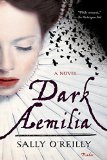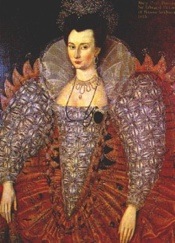Summary | Excerpt | Reading Guide | Reviews | Beyond the Book | Read-Alikes | Genres & Themes | Author Bio

A Novel of Shakespeare's Dark Lady
by Sally O'ReillyThis article relates to Dark Aemilia
Despite possibly being the most famous and applauded writer that has ever lived, very little about William Shakespeare is known for certain. There are few contemporary accounts and the portraits that are generally held to be of him were all painted long after his death. His name is spelled differently in the few copies of his signature that survive. Although is he believed to have married Anne Hathaway and fathered three children with her, next to nothing is known of his private life in the eight years he spent in London while his family remained in Stratford-upon-Avon. It is not certain in which order he wrote his plays or even how many there were. His authorship of the plays is also questioned, as is his sexuality, particularly because of his sonnets. Three principal characters are addressed by the poet: the Fair Youth, the Rival Poet and the Dark Lady. Many academics have attempted to identify these individuals, but with so little known about Shakespeare's life and times, there are several candidates vying for each role.
The Dark Lady sonnets, from 127 to 152, describe a passionate but unhappy affair. The poet expresses great anger, jealousy and resentment. Little can be learned about his subject from the sonnets themselves, beyond the facts that she has dark hair and eyes, is musically inclined and was probably married. At a time when "fairness" was synonymous with beauty, the dark appearance of the poet's lover – assuming it is a literal rather than symbolic description – is intriguing and also narrows the field considerably. The women that historians and scholars can find to fit the bill are few and far between.
In Dark Aemilia, Sally O'Reilly takes Aemilia Lanyer (sometimes spelled Emilia Lanier) for her choice of Dark Lady and weaves a fictional love affair between her characters that fits with the story of love and recrimination described in the sonnets. The real Aemilia was born in London in 1569, was the mistress of Lord Hunsdon and did become, as she longs to in the novel, one of the first published female poets in England. Like Shakespeare, firm biographical facts about Aemilia are hard to find, but the facts that do exist – such as her visits to the astrologer Simon Forman - have been woven expertly into O'Reilly's story. Aemilia was first identified as the Dark Lady by the historian A. L. Rowse, but her status is by no means conclusive, resting mainly on her Italian heritage and dark hair (sonnet 127), on her musical ability (sonnet 128) and her involvement with another man as well as the poet (sonnet 152).
 Before Aemilia's name was suggested, another woman, Mary Fitton, was thought to be the Dark Lady. This gentlewoman and maid to Queen Elizabeth was the mistress of William Herbert. As Herbert is one of the men considered, along with Henry Wriothsley, as the inspiration for the Fair Youth of the sonnets, a link between Mary and Shakespeare was established - but there seems to be little other evidence to support the claim.
Before Aemilia's name was suggested, another woman, Mary Fitton, was thought to be the Dark Lady. This gentlewoman and maid to Queen Elizabeth was the mistress of William Herbert. As Herbert is one of the men considered, along with Henry Wriothsley, as the inspiration for the Fair Youth of the sonnets, a link between Mary and Shakespeare was established - but there seems to be little other evidence to support the claim.
More recent research has suggested other candidates for the role. In 2013, Dr Saul Frampton of the University of Westminster argued in The Guardian that Shakespeare's lover and the Dark Lady of his sonnets was not Aemilia, but Avis Danyell, the wife of John Florio, an Elizabethan lexicographer and translator. Avis, first suggested as the Dark Lady by Jonathan Bate in The Genius of Shakespeare, was the sister of another poet, Samuel Danyell, but beyond that very little is known of her at all. Even her first name is in doubt.
And not much more is known about another possible Dark Lady, Black Lucy or Lucy Negro, a brothel keeper in Clerkenwell. Lucy was a tenant of theatre owner Philip Henslowe and although Henslowe's acting company were rivals to the Lord's Chamberlain's Men, the company Shakespeare belonged to, he did also put on Shakespeare's plays and this, according to Dr Duncan Salkeld of University of Chichester in an article in The Independent in 2012, makes it highly likely that Shakespeare and Lucy would have crossed paths. Lucy is described as "an arrant whore and bawde" and is deemed to be a fitting match for the "evil female" of the sonnets.
At the end of Dark Aemilia, Sally O'Reilly offers useful historical notes including biographies of the main characters she portrays. She outlines the path that the story weaves between fact and fiction and provides an excellent reading list for those who want to find out more.
Picture of Mary Fitton, a possible candidate for Shakespeare's Dark Lady, from Everseradio.com
Filed under Books and Authors
![]() This "beyond the book article" relates to Dark Aemilia. It originally ran in July 2014 and has been updated for the
June 2015 paperback edition.
Go to magazine.
This "beyond the book article" relates to Dark Aemilia. It originally ran in July 2014 and has been updated for the
June 2015 paperback edition.
Go to magazine.






Your guide toexceptional books
BookBrowse seeks out and recommends the best in contemporary fiction and nonfiction—books that not only engage and entertain but also deepen our understanding of ourselves and the world around us.